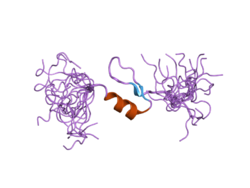
KLF15

2ENT2899966277ENSG00000163884ENSMUSG00000030087Q9UIH9Q9EPW2NM_014079NM_023184NM_001355668NP_054798NP_075673NP_001342597Krüppel-like factor 15 is a protein that in humans is encoded by the KLF15 gene in the Krüppel-like factor family. Its former designation KKLF stands for kidney-enriched Krüppel-like factor. Krüppel-like factor 15 is a protein that in humans is encoded by the KLF15 gene in the Krüppel-like factor family. Its former designation KKLF stands for kidney-enriched Krüppel-like factor. Activated glucocorticoid receptor upregulates the expression of KLF15. KLF15 is increased by fasting and decreased by feeding and insulin via PI3K signalling. KLF15 was increased by glucocorticoid signalling and was also increased by inhibition of PI3K. Insulin and its counteracting hormones regulate the hepatic expression of KLF15. Forced expression of KLF15 in cultured hepatocytes increased both the expression and the promoter activity of the gene for phosphoenolpyruvate carboxykinase (PEPCK). KLF15 levels in both humans and mice increase two to three times in response to exercise and control the ability of muscle tissue to burn fat and generate force. Deficiency of the KLF15 gene in mice was shown to prevent the efficient burning of fat and prevented mice from sustaining aerobic exercise. KLF15 in adipose tissue is down-regulated in obese mice. aP2-KLF15 Tg mice which overexpress KLF15 manifest insulin resistance and are resistant to the development of obesity induced by maintenance on a high fat diet. However, they also exhibit improved glucose tolerance as a result of enhanced insulin secretion. The enhancement of insulin secretion resulted from down-regulation of stearoyl-CoA desaturase-1 (SCD1) in white adipose tissue and a consequent reduced level of oxidative stress. This is supported by the findings that restoration of SCD1 expression in WAT of aP2-KLF15 Tg mice exhibited increased oxidative stress in WAT, reduced insulin secretion with hyperglycemia. The data indicates an example of cross talk between white adipose tissue and pancreatic β cells mediated through modulation of oxidative stress. Using deletion and mutation analysis, EMSA and ChIP, demonstrated that USF1 and Spl can bind to E-box in-80 to-45 and GC-box in-189 to-155 in the KLF15 promoter respectively, thus regulating the transcription of KLF15 gene. KLF15 binding site in the HSD17B5 promoter leading to the upregulation of testosterone production. In addition KLF15 overexpression in combination with insulin, glucocorticoid, and cAMP stimulated adipogenesis in H295R cells. In silico and RT-PCR analyses showed that the KLF15 gene promoter undergoes alternative splicing in a tissue-specific manner KLF15 is a strong and direct activator of BMPER expression which is inhibited by SP1. BMPER is inhibited by endothelin-1, which may be mediated by endothelin inhibition of KLF15. The LRP5 promoter has a KLF15 binding site.
